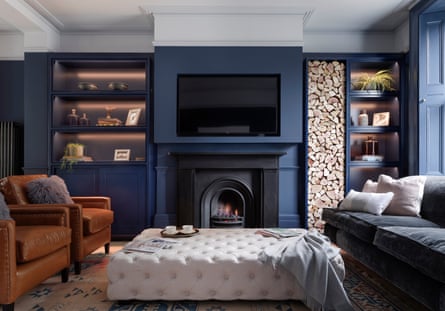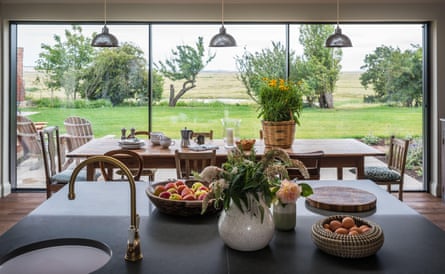Since the first lockdown eased, many homeowners have wanted to improve their properties. The race for space has made loft conversions and extensions popular, while some of those who cannot make structural changes are considering how to remodel their homes.
“Most people have been working or otherwise spending significant amounts of time at home and, probably for the first time, really getting to know why and how their existing home wasn’t working for them,” says Sam Levene, a director of the designers and architects LLI Design. “This, together with large stamp duty costs, means it can be a significantly more appetising proposition to refurbish or extend an existing home to suit your wants and needs rather than move.”
Katy Esdon of Esdon Architecture in Salisbury has been busy since June 2020, when some of the Covid restrictions were first relaxed. “We had about six or seven months of being inundated,” she says. “It’s quietened down a bit but has been steady ever since.”
Her clients generally want extensions and “really wow” conversions – the company has designed new kitchens and remodelled the downstairs of houses to include playrooms and working from home space. There’s “lots of glazing”, Esdon says. “People are moving away from bifolding doors and are instead looking at structural glazing, large sliding panels or Crittall-style glazing as an alternative.”
 View image in fullscreenThe Rooflight Company says the cost of glass, steel, MDF, timber and more has increased in price since the first Covid-19 lockdown. Photograph: Rooflight Company
View image in fullscreenThe Rooflight Company says the cost of glass, steel, MDF, timber and more has increased in price since the first Covid-19 lockdown. Photograph: Rooflight Company
However, that glazing costs considerably more than it did in 2020. According to Nick Cockayne of the Rooflight Company in Oxfordshire, since the first coronavirus lockdown, “glass has increased by 6% to 12% depending on the type, steel has increased from £950 a tonne to £1,500, MDF has shot up by 38%, and silicone, timber, stainless steel and aluminium have all increased in price”.
Painful inflation is not confined to windows. According to the National Federation of Builders, material prices are changing weekly – and are on average 23.5% higher than they were last year. The cost of cement, for example, rose 1% in February, imported timber went down in price by about 20% in the same month but that followed a two-year rise of 200%. The cost of sanitary ware was up 1.9%. Water-based paint went up by 2.3%, while non-water-based paint has risen by 3.1%
“It is therefore very likely that prices [will] increase mid-build, especially for new-build or extensions,” says Rico Wojtulewicz, the head of housing and planning policy at the NFB.
Dealing with rising prices
Most companies giving estimates for home improvements will advise that prices can change – and, with the situation moving so quickly, some are making sure this is spelled out in extra-large print.
Esdon says her practice is being clear with clients about the impact of inflation. “Things have got really expensive,” she says. “We’re telling people that you don’t get as much for your money as you did two or three years ago.”
Her company is advising people to put by more than the traditional 10% contingency fund. It works with builders who are asked to give a fixed-price tender for the work. “This means there are no surprises,” she says. “But they are not valid for as long as they were – before, you might have had a couple of months to make a decision but now they are only valid for two or three weeks.”
 View image in fullscreenA written quote states the price that will be charged for the work the builder has detailed. Photograph: Reeldeal Images/Alamy
View image in fullscreenA written quote states the price that will be charged for the work the builder has detailed. Photograph: Reeldeal Images/Alamy
A written quote states the price that will be charged for the work the builder has detailed – it cannot charge you more unless you later add jobs or change the specification of the materials being used. Make sure that everything you want is included at the outset, if possible. If prices keep rising, things that you add later may come at a higher cost than you anticipate. A builder might not be willing to give a written quote for a job that will be done some months in the future or may make it clear that the quote is only valid for a certain period.
Levene suggests that if you are responsible for buying anything for the build, “where at all possible, if you have out-of-the-way, clean, secure storage at your project, opt to order materials early and store them there. Or, if on-site storage is not possible, negotiate extended delivery dates with your suppliers so you can order something at today’s price but have it delivered as and when your project requires it.”
Most loft conversion companies, for example, ask you to supply the sanitary ware for any bath or shower room you are having installed, so you could buy this sooner rather than later.
Another option may be changing the spec of your original design – Esdon says clients are opting for cheaper cladding or different timbers to keep down costs.
To add to homeowners’ woes, there are long lead times for things such as planning permission, which mean prices could rise before you get started. Permitted development rights cover many extensions and loft conversions now, so this will not be an issue for everyone. But if you live in a conservation area or are doing work not covered by the rights, you may have a long wait.
According to the planning, architect and builder’s company Studio Charrette, case officers at some local authorities are struggling to get through a backlog. “As a result, the timeframe for consumers to get started on their projects, if they have applied to the council for permission, is in excess of three months,” it warns.
Paying for it
 View image in fullscreenMore people are weighing up how to remodel their homes. Photograph: Richard Gooding/LLI Design
View image in fullscreenMore people are weighing up how to remodel their homes. Photograph: Richard Gooding/LLI Design
The good news is that despite recent increases to the Bank of England base rate, borrowing through personal loans and remortgaging remains historically cheap.
Personal loans of up to £50,000 are available and can be arranged over a term of one to eight years, says Andrew Hagger, a finance expert at the website MoneyComms.
“If you’re looking to borrow £20,000 over five years, for example, you can still get rates as low as 2.8% APR with a monthly repayment of £357 – however, you’d need a pristine credit record if you want to bag those best-buy rates,” he says.
Larger loans cost more. Hagger says borrowing £35,000 over seven years starts from about 6.7% APR, which means monthly repayments of about £520. Those rates are fixed, so you do not have to worry about repayments increasing in future months.
Credit cards can be a smart way to pay for home improvementsMoneyComms’ Andrew Hagger
“It’s usually easier and quicker to borrow from your own bank as it should have all your financial details and track record to hand; however, don’t let that stop you from shopping around – the biggest banks aren’t always the cheapest,” he adds.
Some big banks will give you an instant decision and put the money in your account the next day.
A personal loan will be easier to arrange than a mortgage, typically. But on larger amounts the rate will be lower, and you can spread the repayments over a longer term.
Credit cards can be a smart way to pay for home improvements, especially if you’re looking for a smaller sum, Hagger says. There are still cards offering up to two years’ interest-free borrowing on purchases, from brands such as Barclaycard, Sainsbury’s Bank, Tesco and MBNA.
“It’s always worthwhile putting an element on your credit card, as this gives you the added section 75 protection should you hit a snag with your builder and the improvements don’t come up to scratch,” Hagger says.
Is it worth it?
 View image in fullscreenGlazing costs much more than it did in 2020. Photograph: Andreas von Einsiedel/Alamy
View image in fullscreenGlazing costs much more than it did in 2020. Photograph: Andreas von Einsiedel/Alamy
Yes, if you like where you live and want your home to suit your needs. During the stamp duty holiday, when you could save up to £15,000 in tax, moving became more appealing to those who wanted extra space. Now that money will go some way towards buying you a basic loft conversion, with no dormer, and you will save the cost and hassle of a move.
Not necessarily, if you are hoping to recoup the costs when you move. Jonathan Rolande of the National Association of Property Buyers says that when it comes to return on investment, “loft extensions need to add a required benefit to give a return on the very high cost. If a house already has five bedrooms, will a sixth add very much? Not usually.”
He adds: “Double glazing won’t add a huge amount – buyers expect a home to have working windows. Kitchens and bathrooms that give a wow factor will help the property sell faster and for more.”
How much will the work on your home cost?
The cost of your project will vary depending on where you live, the size of your home and the scale of the building work, and your choice of fixtures and fittings. The following are guide prices (excluding VAT) for a “standard” project, taken from the website MyBuilder.com and covering the building work only.
Small single-storey extension (3 metres x 5 metres): £16,000 to £21,000.
Medium extension (4m x 6m): £26,000 to £34,000.
Large extension (6m x 8m): £52,000 to £67,000.
Creating a loft room: £17,500.
Loft conversion with dormer: £45,000.
Hip to gable loft conversion: £54,000.
PVC lean-to conservatory (4m x 3m): £9,000 to £11,000.
Edwardian-style conservatory (4m x 3m): £10,000 to £12,000.
Victorian-style conservatory (4m x 3m): £11,000 to £14,000.
Painting (two-bed flat): £1,500 to £2,500.
Painting (five-bed room): £3,500 to £5,000.
This article was amended on 3 April 2022 to clarify that the figures quoted from MyBuilder.com do not include VAT, charged at 20%, and are calculations for a standard build – noting there are many variables within a project that can affect cost.

